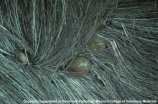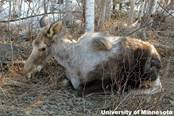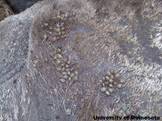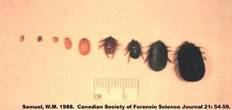|
|
| |
| Causative Agent |
-
The winter
tick,
Dermacentor albipictus,
is a skin parasite of wild
ungulates that consumes a blood meal
from its host to complete its life cycle.
-
While winter ticks have most often been found on moose (Alces alces), other wildlife species have been known
to be parasitized by and have disease caused by D. albipictus,
including:
-
moose (Alces alces);
-
caribou (Rangifer tarandus);
-
elk
(Cervus canadensis).
-
Unlike
mites,
ticks are visible to the naked
eye. Adult winter
ticks are large and reddish-brown
to grayish-brown in color.
|
| Images |
|
Click on images to
enlarge. |
 |
 |
 |
|
Ticks engorged with blood |
In early spring, moose may be showing large patches of broken or missing
hair where they have tried to rub away ticks. Moose with large
patches of broken hair are sometimes referred to as “ghost”
moose, as the white base of the hair shaft is all that remains. |
Heavy infestation of winter tick on a moose. |
 |
Life stages of the winter
tick.
Left to right: larva; nymph; adults (with visible legs).
The last two specimens on the right are adult females
engorged with blood. |
|
| Distribution |
|
Geographic: |
-
Mostly occurring up to 62ºN latitude in western Canada.
-
Greatest abundance in forested, upland or
mountain habitats.
|
|
Seasonality: |
-
All stages of this parasite on large mammal hosts occur between fall and
spring.
|
|
| Hosts, Transmission and Life
Cycle |
| Hosts: |
-
D. albipictus
requires one host to
complete its life cycle.
-
Hosts: highest
tick densities are found on
moose, but also found on elk, deer and mountain sheep.
-
Individual moose have been
found with > 50,000
ticks.
|
|
Transmission and Life Cycle: |
-
Ticks
require blood meals from a host to complete each stage of
their life cycle.
-
In
the host-seeking stage, larvae climb and congregate on tips
of vegetation in September and October. Larvae are very
resistant to cold and snow.
-
Once
on the host, a blood meal is taken and larvae molt to nymphs
and become adults by March-April.
-
Adults that are fully engorged with blood detach in late
March through April and lay eggs among leaves or in soil in
June. The adults are less resistant to cold and snow at this
time.
-
Eggs
hatch and larvae seek hosts to repeat the cycle.
|
|
| Signs and Symptoms |
-
Feeding by D.
albipictus can result in local
inflammation,
edema,
hemorrhage, irritation, and hair loss from grooming.
-
Heavily infested hosts groom extensively and may suffer
from extensive hair loss, loss of body fat stores, loss of blood and
even death from exposure and
starvation. The incessant need to groom can seriously interfere
with feeding.
-
Moose may rub against trees and other objects in
attempts to remove
ticks.
-
Moose with extensive hair loss look white or grey in appearance and
are often called ‘ghost moose’. They are prone to heat loss in
winter.
-
Other
ungulate
species are less affected by winter
ticks
than moose and, although there can be significant hair loss, it is
rare to see other species in as poor condition.
|
| Meat Edible? |
-
Meat is edible but the
quality may be reduced if the animal is in poor condition.
|
| Human Health Concerns and
Risk Reduction |
-
D.
albipictus
may parasitize humans
but this appears to be rare.
-
D. albipictus
is not known to carry and transmit agents that may cause disease in
people.
-
Transfer of D. albipictus to domestic animals
may occur. The response of domestic animals to
tick
infestation is similar to that of wild mammals.
|
| Samples for Diagnosis |
-
Remove
tick from hide
while being careful not to leave mouth parts embedded in the skin.
|
| Further Reading |
|
|
|
|



